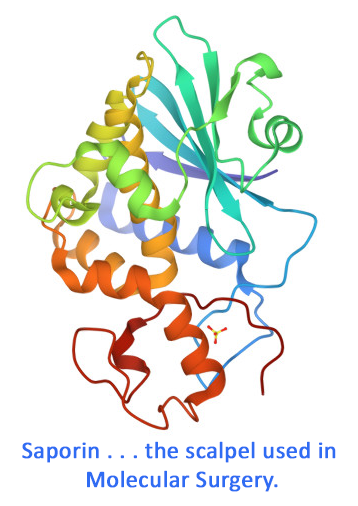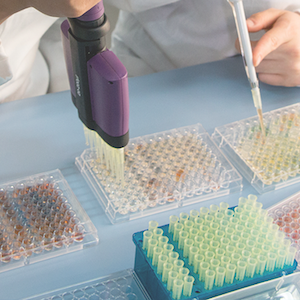Streptavidin-pHast is one of our fastest tools for quantitative testing of your biotinylated protein’s specificity, binding, and internalization, providing results in 1 day. Streptavidin-pHast binds to your biotinylated protein and contains a pH-dependent fluorescent reporter (pHast). This fluorescent reporter will increase intensity as the pH of its surroundings becomes more acidic, as evident when exposed to the environment inside a cell.
This secondary conjugate recognizes YOUR biotinylated protein. Streptavidin-pHast is a conjugate of streptavidin and a pH-dependent fluorescent reporter.
Streptavidin-pHast is available with these fluorescent dyes:
- Red (Cat. #PH-03R) pHast fluorescent dye has an excitation wavelength of 532 nm with an emission maxima at 560 nm.
- Far-Red (Cat. #PH-03F) pHast fluorescent dye has an excitation wavelength of 643 nm with an emission maxima at 660 nm.
- Green (Cat. #PH-03G) pHast fluorescent dye has an excitation wavelength of 453 nm with an emission maxima at 522 nm.
- Blue (Cat. #PH-03B) pHast fluorescent dye has an excitation wavelength of 362 nm with an emission maxima at 452 nm.
Approximately 17 micrograms of Streptavidin-pHast is enough to test 1 biotinylated protein (6 replicates at 8 different concentrations) with a starting concentration of 100 nM in a 96-well plate.
pHast Conjugates:
View a table of targets and recommended pHast conjugates for testing your primary antibody specificity.
keywords: pHast, Fluorescence, pH-sensitive, dye, secondary, screen, internalization, streptavidin, strep-pHast, streptavidin-pHast
SLC46A3 as a potential predictive biomarker for antibody-drug conjugates bearing noncleavable linked maytansinoid and pyrrolobenzodiazepine warheads.
Kinneer K, Meekin J, Tiberghien AC, Tai YT, Phipps S, Kiefer CM, Rebelatto MC, Dimasi N, Moriarty A, Papadopoulos KP, Sridhar S, Gregson SJ, Wick MJ, Masterson L, Anderson KC, Herbst R, Howard PW, Tice DA (2018) SLC46A3 as a potential predictive biomarker for antibody-drug conjugates bearing noncleavable linked maytansinoid and pyrrolobenzodiazepine warheads. Clin Cancer Res 24(24):6570-6582. doi: 10.1158/1078-0432.CCR-18-1300 PMID: 30131388
Objective: To develop biomarkers to uncover the underlying mechanism of resistance by certain cell lines for ADCs.
Summary: Loss of SLC46A3 expression was found to be a mechanism of innate and acquired resistance to ADCs bearing DM1 and SG3376.
Usage: For Lysosomal trafficking, ADCs were labeled with Fab-pHast human (Cat. #PH-01). Cells were incubated with 3 mg/mL of labeled ADCs at 37°C for desired time points and fluorescence quantified by flow cytometry.
Related Products: Fab-pHast human (Cat. #PH-01)
Streptavidin-pHast: A readily conjugatable, pH-sensitive dye to screen for internalization.
Shramm PA, Ancheta L (2019) Streptavidin-pHast: A readily conjugatable, pH-sensitive dye to screen for internalization. Cancer Res 79(13 Suppl):2177. Proceedings of the American Association for Cancer Research Annual Meeting, Atlanta GA. PMID: 909090
Summary: Quick and efficient screening of targeting agents that internalize effectively is vital for determining their suitability as potential therapeutics. Some of the most recent successes in the treatment of cancers have been from antibodies to cell surface proteins that are responsible for tumor cell proliferation. Examples are Cetuximab (target: EGFR) approved for colorectal cancer, and Trastuzumab (target: HER2) for breast cancer. These antibodies have more than one effect on the cancer cell, but one of the most important is that, upon binding to the cell surface antigen, the complex is internalized. As such, the down-regulated cell surface protein no longer plays a role in cancer cell division. Here we describe a method for determining internalization of cell surface molecules by targeting agents using a pH-dependent fluorescent reporter cross-linked to streptavidin. Streptavidin is a tetrameric protein (molecular weight 53 kDa in its recombinant form), with each subunit able to bind a single biotin molecule. The bond between streptavidin and biotin is rapid and essentially non-reversible, unaffected by most extremes of pH, organic solvents, and denaturing reagents. It is the strongest known noncovalent biological interaction (Ka = 1015 M-1) between protein and ligand. A variety of molecules, including lectins, proteins, and antibodies, can be biotinylated and reacted with streptavidin-labeled probes or other detection reagents for use in biological assays. The fluorescence from this reporter increases intensity as the pH of its surroundings becomes more acidic, as demonstrated when exposed to the environment inside a cell (thereby providing evidence of internalization). Here we describe methods that can be used to explore candidates as cancer therapeutics in a quick, reliable and reproducible manner.
Related Products: Streptavidin-pHast (Cat. #PH-03)
View complete Poster.
See Also:
A rapid, pH-sensitive screening method to detect internalization of cell surface markers for development of antibody-based pharmaceuticals to treat brain tumors
Shramm PA, Ancheta L, Higgins D, Lappi DA (2017) A rapid, pH-sensitive screening method to detect internalization of cell surface markers for development of antibody-based pharmaceuticals to treat brain tumors. Neuroscience 2017 Abstracts 566.24 / H7. Society for Neuroscience, Washington, DC.
Summary: Some of the most potent treatments for cancers have been antibodies to cell surface proteins that cause tumor cell proliferation. Examples are cetuximab (antigen: EGFR) approved for colorectal cancer and Trastuzumab (ERBB2) for breast cancer. These antibodies have more than one effect on the cancer cell, but one of the most important is that, upon binding to the cell surface antigen, the complex is internalized by so-called antibody mediated internalization. As such, the mitogenic cell surface protein no longer plays a role in cancer cell division. Despite the blood brain barrier challenging systemic treatment for brain tumors, intracerebroventricular injection can produce similar results. For example, Gholamin et al., (Sci Transl Med 9:381, 2017) and Kang et al. (Sci Rep 6:34922, 2016) reported down-regulation of brain tumor mitogenic agents through antibody-mediated endocytosis. The quick and efficient screening of antibodies that internalize effectively is vital for determining suitability of an antibody as a therapeutic targeting agent. Here we describe a method for the efficient determination of internalization of cell surface molecules by antibodies using a pH-dependent fluorescent reporter cross-linked to a secondary antibody in a plate-based assay with visualization of internalization in hours. This conjugate is comprised of an affinity-purified monovalent secondary antibody against both the heavy and light chain of human or mouse IgG and is conjugated to a pH -dependent fluorescent reporter. The fluorescence from this reporter increases intensity as the pH of its surroundings becomes more acidic, as evident when exposed to the environment inside a cell (thereby providing evidence of internalization). A successful assay protocol has been developed to provide an EC50 by way of a fluorescence-detecting plate reader, which could be used to explore antibody candidates as therapeutics in a quick and reproducible manner.
Related Products: Fab-pHast human (Cat. #PH-01)
View complete Poster.
See Also:
- Gholamin S et al. Disrupting the CD47-SIRPα anti-phagocytic axis by a humanized anti-CD47 antibody is an efficacious treatment for malignant pediatric brain tumors. Sci Transl Med 9(381):eaaf2968, 2017.
- Kang BR et al. Cell surface GRP78 as a biomarker and target for suppressing glioma cells. Sci Rep 6:34922, 2016.
- Ancheta LR et al. Basigin-2 (EMMPRIN), a prognostic marker, is a dynamic portal of entry into cancer cells. Cancer Res 71(8):5218, 2011. Proceedings of the American Association for Cancer Research Annual Meeting, Orlando, FL
- Ancheta L et al. Method for screening neuronal tumor cell surface markers for high specificity and rapid internalization as potential oncologic treatments. Neuroscience 2017 Abstracts 612.11 / SS46, 2017. Society for Neuroscience, Washington, DC
browse all references for this product | back to top



Reviews
There are no reviews yet.